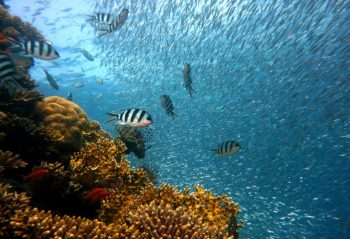
New hope for reef fish living in a high CO2 world
Chemical changes in the ocean, as a result of climate change, are leading to a more acidic environment, referred to as ‘ocean acidification’ (OA). In a laboratory setting, these changes have been shown to lead to a range of risky behaviours in the affected fish, with some fish unable to flee from their finned foes effectively.
But, when researchers recalibrated experiments to adjust for natural daily changes in concentrations of dissolved carbon dioxide (CO2), the primary chemical driver of OA, they found that the fish were less affected than previously thought.
“Shallow water habitats where reef fish live can experience substantial natural fluctuations in water chemistry throughout the day,” explained senior author Professor Philip Munday, of the ARC Centre of Excellence for Coral Reef Studies (CoralCoE) at James Cook University.
“For example, carbon dioxide levels on coral reefs are often much lower during the day than they are at night.”
Did you know night time was like man-made global warming? Or more correctly — man-made global warming is like night time (only not as severe).
“Our data suggests that these natural daily changes in water chemistry are enough to provide fish with a recovery period, reducing their sensitivity to higher carbon dioxide levels,” said Michael D. Jarrold, lead author of the study and Ph.D. student at James Cook University.
Who could have known that day time is a recovery period from the ravages of the night?
Or thinks Jo, wickedly, perhaps fish already have genes for adapting to climate-change, I mean, the 24-hour cycle? Imagine the poor fish that don’t? Like — what a shock — ocean acidification hits at 7 pm again, and I can’t deal with it? Four hundred million years of evolution, and “oh my codfish!” here’s another night I’m not prepared for?
The study published today in Scientific Reports, utilised state-of-the-art facilities at James Cook University and at the Australian Institute of Marine Science’s National Sea Simulator (SeaSim) to mimic the natural conditions of a coral reef environment.
“It’s the first time these dynamic natural conditions have been reproduced in a laboratory setting to test their potential influence on the behaviour of coral reef fish,” explained Mr. Jarrold.
Similar dynamic natural conditions were presumably available in most of the world’s reefs. Surely scientists knew there were big pH swings in natural shallow water? Unless I’m reading this wrongly (see the numbers below), it would be remarkable if fish could not cope with a man-made change that takes 100 years and is 150 times smaller than what some fish deal with every day?
At least, to their credit, this team admitted this was better news than past releases.
“We are thrilled about what we’ve found,” he added. “Our results provide a greater level of optimism for reef fish populations in the future.”
What they could have said was that previous researchers were too quick to announce dire results, and scientists forget how adaptable life can be.
From the paper itself — look at how large the variation is naturally:
In shallow reef areas, diel variation in pCO2 can range anywhere from ±50 to 600 µatmaround the mean…
“Diel” means a 24-hour cycle and 600 micro-atmospheres is apparently loosely equivalent to a bit less than 600ppm. If I’m reading that correctly, it would mean that some fish are coping with something like 300 years worth of man-made climate change every night. Did someone say man-made climate change is unprecedented? Only since breakfast, and maybe not that long.
When did scientists learn of the large diurnal variation in pH?
I thought, surely scientists have known about the large day-night swings of pH for a long time, but of the four papers Jarrold cites, only one was published before 2012. (I reported on another different paper in 2012 showing large daily pH variations). So it appears to be a recent discovery that pH shifts so quickly.
Way back in 1995, Kayanne et al found “reef waters exhibited large diurnal changes ranging from 160 to 520 micro-atmospheres”. So the clues were there, but perhaps researchers didn’t realize how widespread it was.
The day–night shift in Kayanne et al, changes according to “to the light intensity”, and I’m reminded of the corn fields of Ohio that start sucking the CO2 out of the sky at sunrise and slow down when the atmospheric CO2 falls each day by lunch time. CO2 then rises back up each night over the cornfields and the cycle begins again. (Chapman 1954).
The real story here is buried between the lines. This is written up as a “new discovery” shows things won’t be so bad for fish with climate change, but the real story is that scientists are just realizing how much water conditions vary on a daily basis and how well adapted fish are to those big natural swings. Past papers issued dire warnings about fish living under stable low pH conditions, but put fish in tanks with low pH and wild swings, and the fish cope much better.
Ask not if your tank is stable enough, but if it varies enough?
Read more at JoNova
















CO2 is natural it comes from volcano’s all living things and swamps/wetlands and is not a pollutant as the eco-wackos have claimed